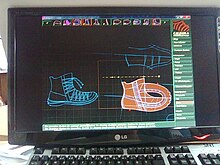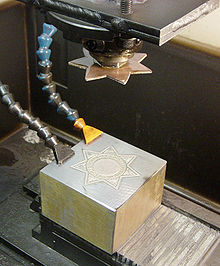This is an old revision of this page, as edited by Pi314m (talk | contribs) at 06:50, 4 November 2020 (→Computer-aided design (CAD): wikilink). The present address (URL) is a permanent link to this revision, which may differ significantly from the current revision.
Revision as of 06:50, 4 November 2020 by Pi314m (talk | contribs) (→Computer-aided design (CAD): wikilink)(diff) ← Previous revision | Latest revision (diff) | Newer revision → (diff)| This article is actively undergoing a major edit for a little while. To help avoid edit conflicts, please do not edit this page while this message is displayed. This page was last edited at 06:50, 4 November 2020 (UTC) (4 years ago) – this estimate is cached, update. Please remove this template if this page hasn't been edited for a significant time. If you are the editor who added this template, please be sure to remove it or replace it with {{Under construction}} between editing sessions. |
CAD/CAM refers to the integration of Computer-aided design (CAD) and Computer-aided manufacturing (CAM). Both of these require powerful computers. CAD software helps designers and draftsmen; CAM "reduces manpower costs" in the manufacturing process.

Overview
Both CAD and CAM are computer-intensive. Although, in 1981, Computervision was #1 and IBM was #2, IBM had a major advantage: it's systems could accomodate "eight to 20" users at a time, whereas most competitors only had enough power to accomodate "four to six." CAD/CAM was described by The New York Times as a "computerized design and manufacturing process" that made its debut "when Computervision pioneered it in the 1970's."
Other 1980s major players in CAD/CAM included General Electric and Parametric Technology Corporation; the latter subsequently acquired Computervision, which had been acquired by Prime Computer.

Computer-aided design (CAD)
Main article: Computer-aided designOne goal of CAD is to allow quicker iterations in the design process; another is to enable smoothly transitioning to the CAM stage. Although manually created drawings historically facilitated "a designer's goal of displaying an idea," it did not result in a machine-readable result that could be modified and subsequently be used to directly build a prototype.
CAD, when linked with simulation, can also enable bypassing building a less than satisfactory test version, resulting in having "dispensed with the costly, time-consuming task of building a prototype."
Computer-aided manufacturing (CAM)
Main article: Computer-aided manufacturing
See also
References
- ^ Eric N. Berg (March 24, 1985). "CAD/CAM's Pioneer Bets It All". The New York Times.
- ^ Barnaby J. Feder (January 18, 1981). "Bolts and Brackets by (Computer) Design". The New York Times.
- ^ Robert Metz (October 28, 1981). "A 'New' Face In CAD/CAM". The New York Times.
- "G.E.'s Expansion into CAD/CAM". The New York Times. January 18, 1981.
- ^ Glenn Rifkin (June 18, 1992). "Designing Tools For the Designers". The New York Times.
- "Computer-aided design" (PDF).
- "What is Computer-Aided Design (CAD) and Why It's Important".
- "A Guide to CAD/CAM Software". Thomas Register.
- "CAD". Stanford University Student Journals.
- "Intelligent computer-aided design systems".
This computing article is a stub. You can help Misplaced Pages by expanding it. |
This software article is a stub. You can help Misplaced Pages by expanding it. |